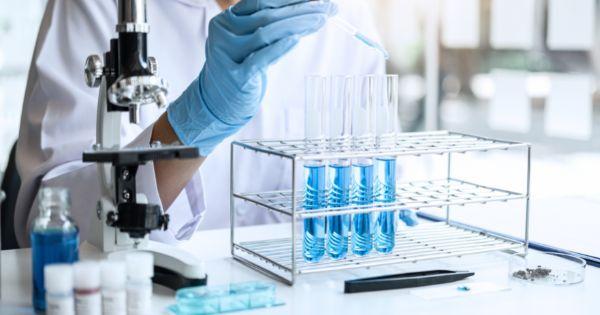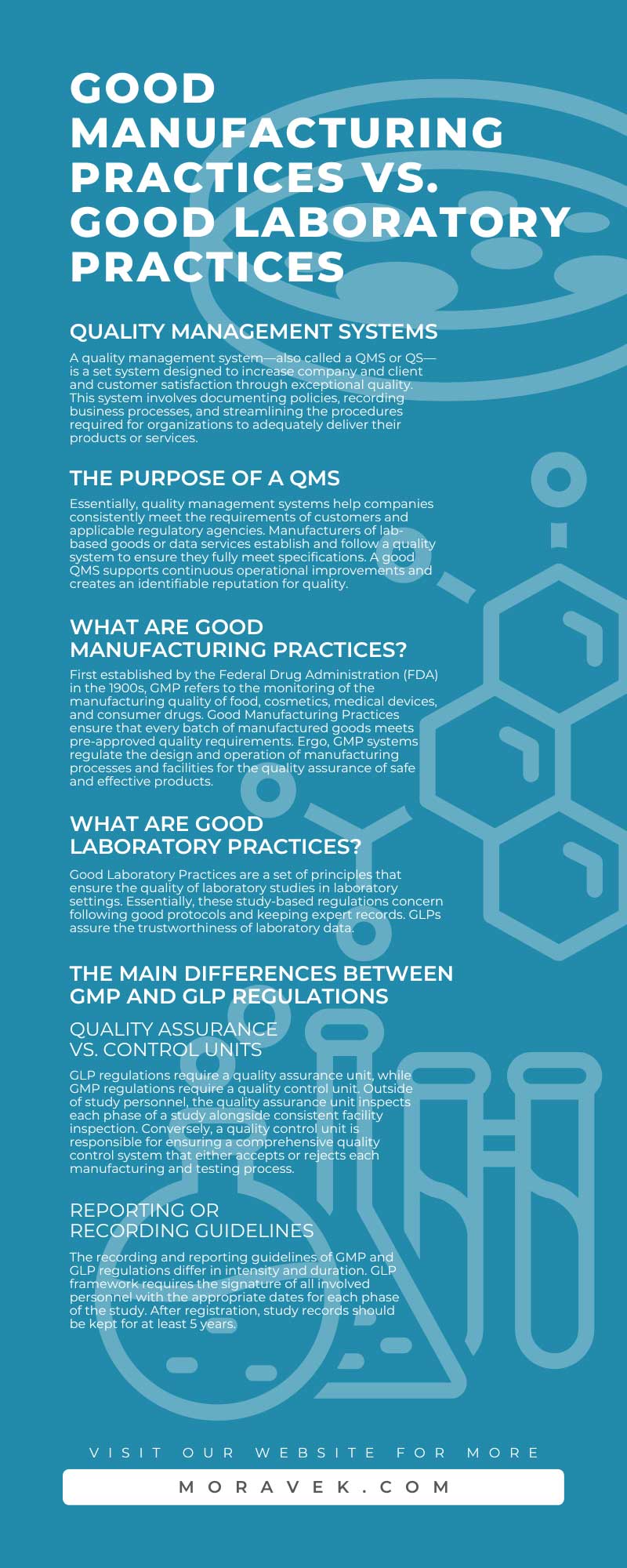
Peter Drucker, the inventor of management, recognized that, “Quality in a service or product is not what you put into it. It is what the client or customer gets out of it.” Quality standards—especially those with clearly defined requirements—allow companies to better meet consumers' definitions of quality. By following set guidelines, manufacturers can improve their understanding of what quality compliance and assurance means.
Quality is everything in laboratory science. The results of scientific research—either data or goods—are consistently held to high standards. Good manufacturing practices or good laboratory practices serve as the framework for quality management systems in these environments.
Due to their similar terminology, you’ll find some overlap between Good Manufacturing Practices vs. Good Laboratory Practices. Nonetheless, these quality management systems, principles, and applications differ widely in the pharmaceutical industry. Read on for a comprehensive guide outlining GMP and GLP regulations.
Quality Management Systems
Quality standards are useless without a clear understanding of how they apply to specific products or services in the industry. In this scenario, quality management systems come into the picture to lay down the foundation and build up the walls of the framework.
A quality management system—also called a QMS or QS—is a set system designed to increase company and client and customer satisfaction through exceptional quality. This system involves documenting policies, recording business processes, and streamlining the procedures required for organizations to adequately deliver their products or services.
The Purpose of a QMS
Essentially, quality management systems help companies consistently meet the requirements of customers and applicable regulatory agencies. Manufacturers of lab-based goods or data services establish and follow a quality system to ensure they fully meet specifications. A good QMS supports continuous operational improvements and creates an identifiable reputation for quality.
The ability to provide quality assurance also helps new customers know what to expect while maintaining the trust of existing clients—not to mention aiding overall compliance efforts for GMP or GLP-certified services or studies. Compliant pharmaceutical production relies on adherence to industry-specific quality standards.
Depending on the situation in question, meeting either pre-defined criteria for good manufacturing practices or good laboratory practices may be appropriate. Either way, any generated quality system data provides critical insight to minimize the possibility of compliance issues with these practices.
What Are Good Manufacturing Practices?
First established by the Federal Drug Administration (FDA) in the 1900s, GMP refers to the monitoring of the manufacturing quality of food, cosmetics, medical devices, and consumer drugs. Good Manufacturing Practices ensure that every batch of manufactured goods meets pre-approved quality requirements. Ergo, GMP systems regulate the design and operation of manufacturing processes and facilities for the quality assurance of safe and effective products.
The purpose of GMP regulations is to protect consumers against any risks of harm from contamination or mix-ups during production. Any goods developed for human use fall under this category. The guidelines for Good Manufacturing Practices outline the appropriate steps to follow to meet the FDA requirements for regulated products. Furthermore, GMP compliance protocols rely on heavily-tested scientific principles, requiring strict quality management of facilities, equipment, and processes.
When Is GMP Applicable?
Good Manufacturing Practices are applicable during batch release, manufacturing and testing, and medicinal product marketing phases. The testing phase of components commonly utilized in clinical trials—such as active pharmaceutical ingredients—can also require GMP compliance. Investigational drug, process validation, stability studies, and other types of supportive testing can also require compliance. cGMP manufacturing services must follow good manufacturing practice guidance to guarantee safety and efficacy.
What Are Good Laboratory Practices?
On the other hand, Good Laboratory Practices are a set of principles that ensure the quality of laboratory studies in laboratory settings. Essentially, these study-based regulations concern following good protocols and keeping expert records. GLPs assure the trustworthiness of laboratory data.
Commonly associated with the pharmaceutical industry, GLP refers to the governing of research facility conditions, such as personnel, testing and controls, organization, equipment, and reports. Designed to protect the integrity of scientific data, GLP systems provide regulatory agencies with a clear and auditable record of research. The FDA can closely inspect studies that are the foundation of potential products to be marketed. GLP-compliant studies protect the public from unprincipled health practices.
When Is GLP Applicable?
GLP systems define the standards for a study’s conduct, data analysis, and reporting for regulatory agencies. Good Laboratory Practices are applicable during safety and test system studies that support the research of pharmacology, toxicology, or other medical products. Additionally, GLP standards apply to studies that require safety and efficacy testing for future marketing.
The Main Differences Between GMP and GLP Regulations
When comparing good manufacturing practices vs. good laboratory practices, there are two differences worth noting besides their applications.
Quality Assurance vs. Control Units
GLP regulations require a quality assurance unit, while GMP regulations require a quality control unit. Outside of study personnel, the quality assurance unit inspects each phase of a study alongside consistent facility inspection. Conversely, a quality control unit is responsible for ensuring a comprehensive quality control system that either accepts or rejects each manufacturing and testing process.
Reporting or Recording Guidelines
The recording and reporting guidelines of GMP and GLP regulations differ in intensity and duration. GLP framework requires the signature of all involved personnel with the appropriate dates for each phase of the study. After registration, study records should be kept for at least 5 years.
When it comes to GMP recordkeeping, any reports require the signatures of the personnel conducting manufacturing processes and those validating them. Records must be kept for at least 1 year after a product’s expiration date.
The Importance of Compliant Pharmaceutical Production
Organizations or entities involved in biopharmaceutical, pharmaceutical development, and manufacturing industries can achieve a Good Manufacturing Practices or Good Laboratory Practices certification. Facilities equipped with certification have an enhanced understanding of these regulations. In a complex industry, meeting present-day regulatory requirements is easy with state-of-the-art equipment and personnel with expert knowledge and skillsets.
Certified Compliance Companies
Moravek offers custom API manufacturing practices for worldwide clinical trials and research that meet regulatory agency requirements. As an expert source for radiolabeling services, we are a contract development and manufacturing organizationcertified forcGMP compliance and production of carbon-14-labeled APIs. Learn more about the assurance of Moravek quality or our QC laboratory on our website.

